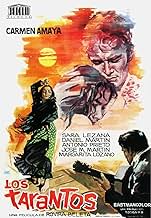Los Tarantos et Los Zorongos sont deux familles gitanes rivales. Un jour, Rafael, issue de la première famille, va tomber amoureux de Juana, la fille du chef du camp adverse..Los Tarantos et Los Zorongos sont deux familles gitanes rivales. Un jour, Rafael, issue de la première famille, va tomber amoureux de Juana, la fille du chef du camp adverse..Los Tarantos et Los Zorongos sont deux familles gitanes rivales. Un jour, Rafael, issue de la première famille, va tomber amoureux de Juana, la fille du chef du camp adverse..
- Réalisation
- Scénario
- Casting principal
- Nommé pour 1 Oscar
- 4 victoires et 1 nomination au total
José Manuel Martín
- Curro
- (as J. Manuel Martín)
Antonia Singla
- Sole
- (as Antonia 'La Singla')
Aurelio Galán 'El Estampío'
- Jero
- (as A. Galán 'El Estampío')
Avis à la une
This is a classic Flamenco must see. The final film of the famous Carmen Amaya. Gritty, lovely and very languid in its style. A good reflection of 60's gypsy life along with the beauty of the people themselves, he captures the children with a very precise and unique cinematography style. Quintisential Spanish film, not released in Canada and often difficult to find. Worth searching out, even if you don't speak Spanish - you will understand the film, due to its clear storytelling style (and the fact that it is loosely based on Romeo and Juliet). For the flamencos out there, you will see the gritty real gitano style dancing - bare feet, fury and individualism soar in each dance. Even the children dance. It is a beautiful movie.
Outstanding adaptation of Alfredo Maña´s play, entitled "La historia de los Tarantos", that in a sort of time and space transposition of Shakespeare's classic "Romeo and Juliet", describes the unlucky love between a couple of young gypsies, pertaining to two different families, deep-rooted opposing and established in the now missing district of Somorrostro, in Barcelona.
Rovira Beleta´s cinema, seriously committed with Catalonia social reality reached and international repercussion with this fable of passion and resentment, embellished with the flamenco superb scenes by Carmen Amaya (in her las film appearance) or a suggestive, night life and irrigated dance by Antonio Gades through the beautiful Ramblas.
Wonderful in its chromatic esthetic and its interpretations, the movie brings a real vision, nearly to the documental pictures, about methods and traditions of this excluded ethnic collective, without falling in the trite and easy lucrative Spanish folklore.
Rovira Beleta´s cinema, seriously committed with Catalonia social reality reached and international repercussion with this fable of passion and resentment, embellished with the flamenco superb scenes by Carmen Amaya (in her las film appearance) or a suggestive, night life and irrigated dance by Antonio Gades through the beautiful Ramblas.
Wonderful in its chromatic esthetic and its interpretations, the movie brings a real vision, nearly to the documental pictures, about methods and traditions of this excluded ethnic collective, without falling in the trite and easy lucrative Spanish folklore.
Le saviez-vous
- AnecdotesFinal film of Carmen Amaya.
- ConnexionsFeatured in Bajarí (2013)
- Bandes originalesLos Tarantos
Written and Performed by Los Tarantos
Meilleurs choix
Connectez-vous pour évaluer et suivre la liste de favoris afin de recevoir des recommandations personnalisées
Détails
- Durée1 heure 23 minutes
- Mixage
Contribuer à cette page
Suggérer une modification ou ajouter du contenu manquant

Lacune principale
By what name was Los Tarantos (1963) officially released in Canada in English?
Répondre


























